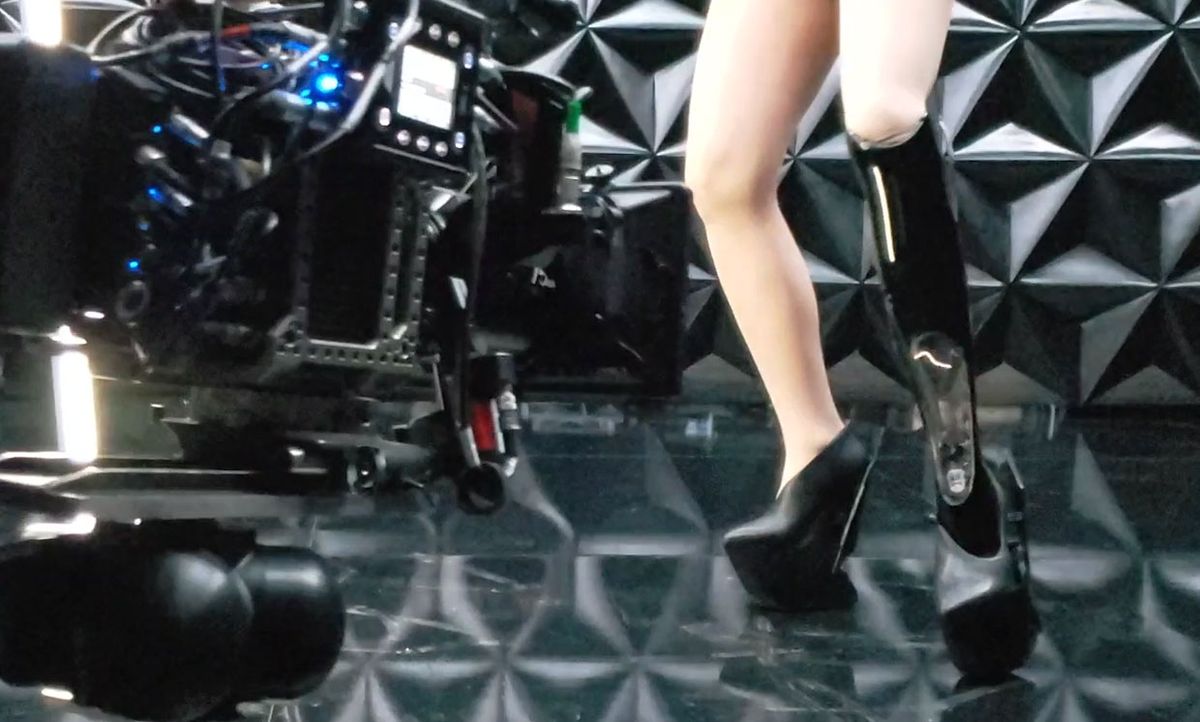Imagine performing complicated choreography with thousands of volts rippling up and down inside your leg, creating a ladder of buzzing miniature bolts of lightning. That’s what Viktoria Modesta does in a promotional art video released this week for Rolls Royce’s line of Black Badge cars. The video, which you can see at the bottom of this page, is in a “cybernetic glam” style that shows Modesta striding through futuristic settings until she transforms into the famous leaning woman ornament that adorns the front bonnet of Rolls Royces.
Modesta is a self-described bionic pop artist who often uses very elaborate versions of her prosthetic limb. To create her outfit for the video—including the 3D printed matching bodice—she turned to fashiontech designer Anouk Wipprecht (who wrote about her creation of a maker-friendly EEG headset in the June issue of IEEE Spectrum) and Sophie de Oliveira Barata of the Alternative Limb Project.
Modesta, Wipprecht, and de Oliveira Barata started visiting their local Rolls Royce dealerships and brainstorming about what Modesta’s look could be for the video. Wipprecht began thinking about using a Tesla coil to generate electric “wings,” and brought on two previous collaborators: Joe DiPrima (profiled in Spectrum’s May issue) and his brother John. The DiPrima’s are the founders of ArcAttack, which makes and performs with Tesla coils. ArcAttack often makes large coils, some of which have been installed as attractions in U.S. science museums. Soon the team began wondering if they could put a Jacob’s Ladder inside a hollow leg. (If you’ve ever seen an old-school mad scientist’s laboratory in a movie, you’re familiar with the rising spark effect of a Jacob’s Ladder).
But while “Jacob Ladders are cool things, they're sort of unreliable. If you're walking around with it and the wind starts blowing and stuff like that, it just breaks the arc. Maybe it might work like one out of five times,” says Joe DiPrima. Given that the video was designed to promote a car, “I thought that maybe we could design a Jacob’s Ladder worked more like a distributor cap in a car. So we have an actual mechanical switch that switches high voltage from the Tesla coil and energizes a specific spark gap. And so by doing that we make the effect bulletproof.” The result was a series of spark gaps which can fire in a Jacob’s Ladder-like way, but with the speed and pattern under the control of a programmable microcontroller. Wipprecht and DiPrima shared withIEEE Spectrum some behind-the-scenes footage of how they prototyped and built the leg for this video:
Making a wearable Tesla coil came with unusual challenges: “A Tesla coil doesn't have a lot of capacitance when they're super small. So they're really sensitive to their surroundings as far as frequency is concerned and stuff like that,” says DiPrima—even a nearby hand can affect the coil. “One of the things that I did to make the frequency of the coil more stable is I put a capacitor string inside of it…that added 20 picofarads of capacitance, which is pretty significant for a coil that small.” As well as stabilizing the coil itself, the extra capacitance gave the design more flexibility with regard to the length of the wires used to connect to the spark gaps in the leg.
It was decided to fit the coil and the supported electronics into a shoe, so they worked with United Nude to make a custom pair that would let them fit everything into the heel. The development process took about six months and grew to include a number of other specialists, such as Alex Freire.
“I’m not a prosthetist,” says Wipprecht. For an artifical leg “there’s really specific needs, like the socket placement, the length of the feet, the balance.” Freire made the sockets and the feet which were then sent to de Oliveira Barata to complete the leg based on Wipprecht’s design sketches, which featured an open space for the spark electrodes. The feet are made of rubber, while the upper part of the prosthetic is made of carbon fiber, but much of the length is made from fiberglass. “That is the space where the electrical effects needed to happen, so it couldn’t be carbon fiber because that’s conductive,” says Wipprecht.
In the finished video, these effects have been enhanced using CGI, but it is still based on real sparks as a practical effect. The bodice Modesta wears is designed to evoke the engine of the Black Badge car. To create it, Wipprecht worked from a 3-D body scan of Modesta, and printed the form using a nylon material with a laser-sintering printer. The printed neck and hip parts were used to make a mold from which parts were cast, which where then layered with the same carbon fiber material used in Black Badge cars.
Stephen Cass is the special projects editor at IEEE Spectrum. He currently helms Spectrum's Hands On column, and is also responsible for interactive projects such as the Top Programming Languages app. He has a bachelor's degree in experimental physics from Trinity College Dublin.



